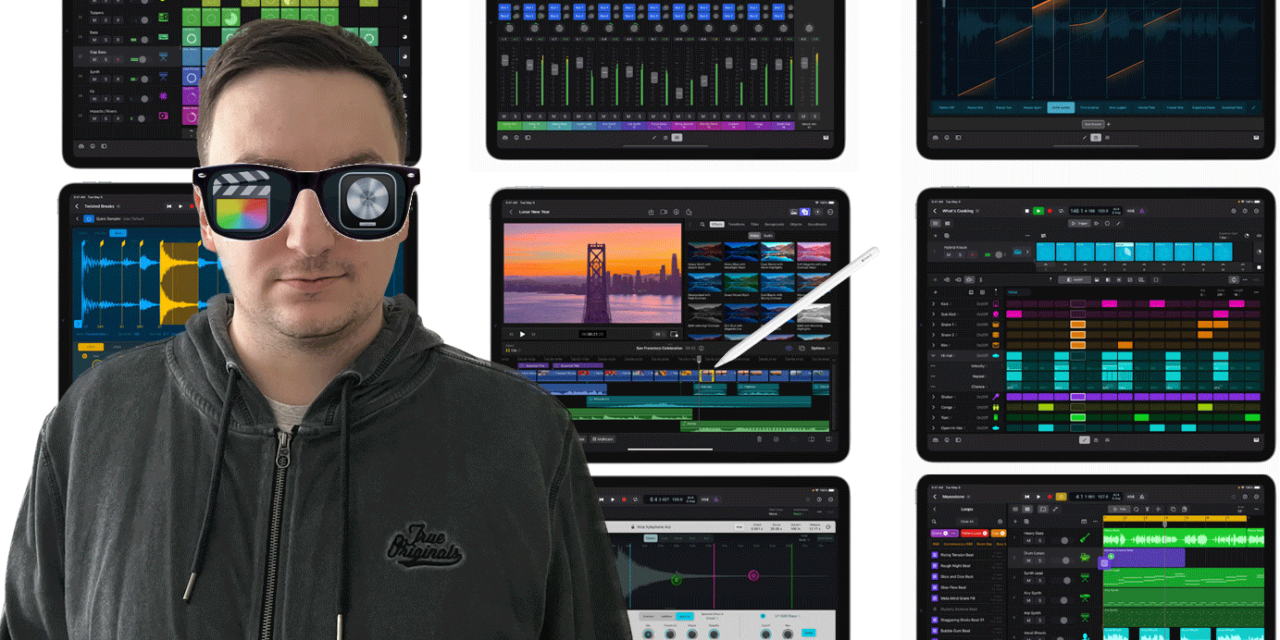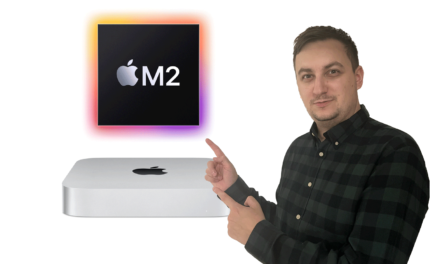If you’re a Mac user familiar with video editing or working with audio, such as in a recording studio, you’ll be pleased to hear Apple’s press release. Now you’ll also be able to use the popular Final Cut Pro and Logic Pro apps on your iPad. Logically, the main advantage is the large touchscreen area of the iPads themselves and even better portability.
At the same time, the control interface will be properly adapted for easy editing, and the Apple Pencil will also be available. Final Cut Pro will be available exclusively on the 12.9″ version of the iPad Pro, while Logic Pro will also be available on the smaller 11″ iPad Pro or iPad Air with M1.
Apple has promoted the philosophy that the iPad can be your new computer for several years. The two devices are now quite close to each other. With the implementation of iPadOS and the subsequent equipping of iPads with chips from Apple’s Silicone line, the differences between iPad and Mac have begun to blur even further.
However, there were still two significant differences between the devices, namely the need for more professional applications and the very simplistic system in the case of the iPad.
But thankfully, we can finally officially put the first of these issues behind us, as today Apple released an official announcement mentioning that Final Cut Pro and Logic Pro apps are heading to the iPad.
Apple says that “these apps bring an all-new touch interface that takes advantage of iPad’s controls. This interface will then allow users to enhance their workflows with the immediacy and intuitiveness of so-called multitouch controls.”
Final Cut Pro for iPadOS
If you’ve ever used Final Cut Pro on a Mac, you know full well that it’s a comprehensive video editing tool that ranks among the best in its industry. The same should be true of the iPad version. Following Mac’s lead, Final Cut Pro will include a digital wheel for navigating the magnetic timeline, moving clips, and making frame-by-frame edits.
Live drawing will allow users to draw and write directly into the video using Apple Pencil. Keyboard shortcuts will be no problem once the iPad’s Final Cut keyboard is connected. Equally important is the implementation of machine learning features. These include the Scene Removal Mask, which quickly removes or replaces the background without using the so-called “Green Screen.”
Furthermore, the iPad doesn’t miss out on automatic cropping to adjust the shot for arbitrary aspect ratios and voice isolation to easily remove unwanted background noise. Then, of course, there’s the library of graphics, effects, and sounds, which includes HDR backgrounds and animated audio track patterns with auto-adaptability to video length.
Media can be imported from the Files and Photos apps. You can then save them directly to a project in Final Cut Pro. However, if you’d like to import projects created in iMovie and finish them in Final Cut Pro, that option also exists here.
Final Cut Pro is a popular editing tool with a few extra features on iPads, most notably Apple Pencil stylus support. With it, you can draw and type directly into video content or scroll around touchless, thanks to the Apple Pencil hover feature. Final Cut Pro for iPad will also be able to record video from multiple cameras at once, including ProRes on tablets with Apple’s M2 chipset.
Thanks to modern chips, advanced editing features will also be available, which should work as fast as on Macs. In addition, owners of the 12.9″ iPad Pro will appreciate viewing and editing HDR video using Reference Mode with accurate colour.
Final Cut Pro includes a digital wheel for navigating the magnetic timeline, moving clips, and making frame-accurate edits. A live drawing feature allows users to draw and write directly on video content using Apple Pencil with hover support to navigate and view the footage.
Keyboard commands are enabled when using an external keyboard. Final Cut Pro on iPad also supports the reference mode of the 12.9-inch iPad Pro for colour-accurate editing.
Machine learning features include a Mask for removing a scene or replacing the background without using a green screen, Auto Crop for adjusting portrait, square and other aspect ratios, and Voice Isolation for easily removing background noise.
The app includes libraries of graphics, effects and sounds, including HDR backgrounds, animation patterns and audio tracks that automatically adjust to the length of the video. Professional Camera Mode allows filmmakers to shoot video in landscape or portrait in Final Cut Pro, monitor audio and recording time, and manually control settings such as exposure, white balance and focus.
Multicam video editing automatically syncs clips for collaborative editing and allows switching angles with a single touch. Media can be imported from files or photos and saved directly in a Final Cut Pro project. The app also supports importing projects created in iMovie, and users can export Final Cut Pro projects created on an iPad to a Mac.
Logic Pro
Like Final Cut Pro, Logic Pro uses “multitouch” gestures, primarily for playing with software tools or browsing individual projects. Keyboard shortcuts are also natively supported here when an external keyboard is connected.
Very important are the plug-ins that allow you to add a lot of additional functions. In the iPad version of Logic Pro, there are more than 100 of these available, and they allow users to “chop” and flip samples and create bass lines, for example.
Touch controls and preloaded
Whether the iPad versions of the apps will include all the features from the PC version is unfortunately not mentioned by Apple in its post. Personally, however, the iPad versions will be trimmed down a bit, but not drastically.
However, the iPad versions bring something extra, namely touch controls, which may be more convenient for users in some scenarios, which could partially compensate for the simplification. The current price of Final Cut Pro and Logic Pro on the Mac is $299.99 and $199.99, respectively.
The iPad version, however, will use a subscription system, with each app costing $4.99 per month or $49.99 per year with a free monthly trial. The apps will then be available starting May 23, when you can install Final Cut Pro on machines with the M1 processor and above and Logic Pro on devices with the A12 Bionic processor and above.
Logic Pro will offer iPad owners something extra: multi-touch gestures that allow for natural control and comfortable play on the software tools. The app will also use the iPad’s internal microphones to record voice or musical instruments, and the Apple Pencil stylus can be used for precise editing.
A new sound viewer will also be available on tablets, and more than 100 instruments and effects plug-ins, professional mixing consoles, production tools, and more will be supported. The Final Cut Pro app will require the tablet to run on at least an Apple M1 chipset, while Logic Pro will make do with an Apple A12 Bionic chipset or later.
Unlike macOS, Apple will not offer the option to buy a one-time license but will offer its tablet apps on a subscription basis. Each one will cost $4.99 or $49 per year, with new users getting a free month to try it out. The Logic Pro app for iPad uses a series of multi-touch gestures to play software tools and navigate projects.
Apple Pencil makes it easy to make precise edits and automate detailed drawn traces. Like Final Cut Pro, keyboard commands are supported when using an external keyboard. Users can also capture audio directly within the app using the iPad’s built-in microphones. The app has a full-featured mixer with channel strips, volume controls, panning, plug-ins, sends, and precision automation.
The multi-touch feature lets creators move and mix multiple faders at once, and the mixer’s meter bridge lets them navigate through an overview of track levels. An all-new audio browser with dynamic filtering helps creators explore all available instrument patches, sound patches, plug-in presets, samples and loops in one place.
Users can tap to listen to any sound before adding it to a project. The app includes over 100 instruments and effect plug-ins for the most important controls. Production tools allow users to chop and flip samples, program beats and bass lines, and create custom drum kits.
A new time and pitch change plugin, Beat Breaker, allows creators to swipe and reshape curves and mix sounds. Quick Sampler can chop and reshape samples into new playable instruments, while Step Sequencer allows users to program drum patterns, basslines and melodies and automate plug-ins.
Drum Machine Designer can create custom drum sample sets and plug-ins on any drum pad. With Live Loops, users can quickly create arrangements.
Logic Pro for iPad supports roundtrip, which allows users to move projects between Logic Pro for Mac and iPad. iPad users can export finished tracks in several lossless and compressed formats and individual audio tracks.
Creators can create an audio track in Logic Pro and export it to Final Cut Pro when working with music and video. Logic Pro for iPad also supports the ability to open projects from GarageBand.
Final thoughts
I’d love to try both apps, but since they’re outside of my current work, I probably won’t get a subscription, but who knows, maybe I’ll be so excited about them that I won’t be able to resist. The question remains, though, when we get “full-featured” video and audio editing tools isn’t Apple going to make one of their image editing apps as well?
DXO Photolab on the iPad Pro could also mean a prolific migration of professional photographers towards the iPad. We’ll have to wait a bit longer. Strangely enough, not until WWDC because we’ll see it as early as May 23. Whether you use the apps is, of course, up for debate.
Apple offers both iMovie and Garageband all the time and, for free, two reasonably capable tools that don’t have the slightest problem with basic operation. Of course, you can run them on a wide range of products, including the basic iPad or iPhones.
One rumour to conclude
According to Bloomberg’s Mark Gurman, Final Cut Pro and Logic Pro apps shouldn’t just be available on iPads. Still, they will reportedly arrive on the upcoming AR/VR headset that will likely be unveiled at the WWDC developer conference in early June.
References:
- https://www.youtube.com/watch?v=EUMNTUxY6dk
- https://www.youtube.com/watch?v=09VkPQZvXo4
- https://www.youtube.com/watch?v=RSbBNJjW_rY
- https://www.youtube.com/watch?v=MLGq2QWNX_M
- https://www.youtube.com/watch?v=0mqWw5UH1qg
- https://www.apple.com/final-cut-pro-for-ipad/
- https://apps.apple.com/us/app/final-cut-pro/id424389933
- https://www.apple.com/logic-pro-for-ipad/
- https://apps.apple.com/us/app/logic-pro/id634148309
- https://www.macrumors.com/2023/05/09/apple-announces-final-cut-pro-and-logic-pro-for-ipad/
- https://www.apple.com/newsroom/2023/05/apple-brings-final-cut-pro-and-logic-pro-to-ipad/
- https://www.macrumors.com/2023/05/09/apple-ar-vr-headset-final-cut-pro/




